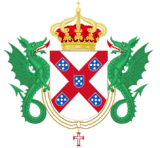Carlos I of Portugal
Dom Carlos I (Portuguese pronunciation: [ˈkaɾɫuʃ]; English: Charles; 28 September 1863 – 1 February 1908), known as the Diplomat (Portuguese: o Diplomata) and the Martyr (Portuguese: o Martirizado), was the King of Portugal from 1889 until his assassination in 1908. He was the first Portuguese king to die a violent death since Sebastian in 1578.
| Carlos I | |||||
|---|---|---|---|---|---|
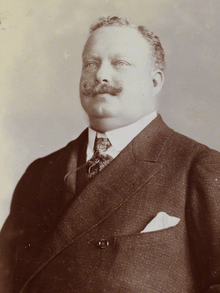 Carlos I circa 1907 | |||||
| King of Portugal | |||||
| Reign | 19 October 1889 – 1 February 1908 | ||||
| Acclamation | 28 December 1889 | ||||
| Predecessor | Luís I | ||||
| Successor | Manuel II | ||||
| Prime Ministers | See list
| ||||
| Born | 28 September 1863 Ajuda Palace, Lisbon, Portugal | ||||
| Died | 1 February 1908 (aged 44) Terreiro do Paço, Lisbon, Portugal | ||||
| Burial | Pantheon of the Braganzas | ||||
| Spouse | Amélie of Orléans (m. 1886) | ||||
| Issue |
| ||||
| |||||
| House | Braganza[1] | ||||
| Father | Luís I | ||||
| Mother | Maria Pia of Savoy | ||||
| Religion | Roman Catholicism | ||||
| Signature | |||||
Early life

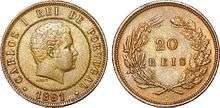
Carlos was born in Lisbon, Portugal, the son of King Luís and Queen Maria Pia, daughter of King Victor Emmanuel II of Italy, and was a member of the House of Braganza.[1] He had a brother, Infante Afonso, Duke of Porto. He was baptised with the names Carlos Fernando Luís Maria Víctor Miguel Rafael Gabriel Gonzaga Xavier Francisco de Assis José Simão.
He had an intense education and was prepared to rule as a constitutional monarch. In 1883, he traveled to Italy, the United Kingdom, France and Germany, where he increased his knowledge of the modern civilization of his time. In 1883, 1886 and 1888, he ruled as regent as his father was traveling in Europe, as had become traditional among the Portuguese constitutional kings. His father Luis I advised him to be modest and to study with focus.
His first bridal candidate was one of the daughters of German Emperor Frederick III, but the issue of religion presented an insurmountable problem, and the pressure of British diplomacy prevented the marriage. He then met and married Princess Amélie of Orléans, eldest daughter of Philippe, comte de Paris, pretender to the throne of France.[2]
King of Portugal
.png)
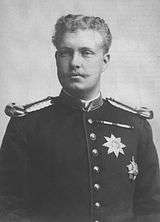

Carlos became king on 19 October 1889. After the 1890 British Ultimatum, a series of colonial treaties were signed with the United Kingdom of Great Britain and Ireland. One signed in August 1890 defined African colonial borders along the Zambezi and Congo rivers, whereas another signed on 14 October 1899 confirmed colonial treaties of the 17th century. These treaties stabilised the political balance in Africa, ending Portuguese claims of sovereignty on the Pink Map, a geographical conception of how Portuguese colonies would appear on a map if the territory between the coastal colonies of Angola and Mozambique could be connected with territory in central Africa. These central African territories were taken over by Great Britain, however, a concession that was viewed as humiliating in Portugal. The agreements were thus looked upon as unpopular in Portugal and were felt to be disadvantageous to the country.
Domestically, Portugal was declared bankrupt twice – on 14 June 1892, then again on 10 May 1902 – causing industrial disturbances, socialist and republican antagonism and press criticism of the monarchy. Carlos responded by appointing João Franco as prime minister and subsequently accepting parliament's dissolution.[2]
As a patron of science and the arts, King Carlos took an active part in the celebration of the 500th anniversary of the birth of Prince Henry the Navigator in 1894. The following year he decorated the Portuguese poet João de Deus in a ceremony in Lisbon.
Carlos took a personal interest in deep-sea and maritime exploration and used several yachts named Amélia on his oceanographical voyages. He published an account of his own studies in this area.[2]
Assassination
On 1 February 1908, the royal family returned to Lisbon from the Ducal Palace of Vila Viçosa in Alentejo, where they had spent time the hunting season during the winter. They travelled by train to Barreiro and, from there, they took a steamer to cross the Tagus River and disembarked at Cais do Sodré in central Lisbon. On their way to the royal palace, the open carriage with Carlos I and his family passed through the Terreiro do Paço fronting on the river. In spite of recent political unrest there was no military escort.[3] While crossing the square at dusk, shots were fired from amongst the thin crowd, by two republican activists: Alfredo Luís da Costa and Manuel Buíça.[4]
Buíça, a former army sergeant and sharpshooter, fired five shots from a rifle hidden under his long overcoat. The king died immediately, his heir Luís Filipe was mortally wounded and Prince Manuel was hit in the arm. The queen alone escaped injury. The two assassins were killed on the spot by police; an innocent bystander Joao da Costa, was also shot dead in the confusion. The royal carriage turned into the nearby Navy Arsenal, where, about twenty minutes later, Prince Luís Filipe died. Several days later, the younger son, Prince Manuel, was proclaimed king of Portugal. He was to be the last of the Braganza-Saxe-Coburg and Gotha dynasty and the final king of Portugal.
Marriage and children
Carlos I was married to Princess Amélie of Orléans in 1886. She was a daughter of Philippe, Count of Paris, and Princess Marie Isabelle of Orléans. Their children were:
- Luís Filipe, Prince Royal of Portugal (1887–1908)
- Infanta Maria Ana of Braganza (1887)
- Manuel II, King of Portugal between 1908 and 1910 (1889–1932)
A woman known as Maria Pia of Saxe-Coburg and Braganza[5][6] claimed to be the illegitimate daughter of King Carlos I of Portugal with Maria Amélia Laredó e Murça. Maria Pia claimed that King Carlos I legitimized her through a royal decree and placed her in the line of succession with the same rights and honours as the legitimately-born princes of Portugal; however, no undisputed evidence was presented to demonstrate this, and the king did not, constitutionally, have the personal authority to do so. Maria Pia's paternity was never proven and her claim not widely accepted.
Honours
- Portuguese[7]
- Grand Commander of the Three Military Orders of Christ, Aviz and St. James
- Grand Cross of the Tower and Sword
- Grand Cross of the Immaculate Conception of Vila Viçosa
- Foreign[7]
.svg.png)
.svg.png)

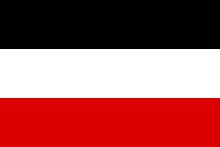
_crowned.svg.png)
- Knight of the Annunciation, 1873[10]
- Grand Cross of Saints Maurice and Lazarus, 1873
- Grand Cross of the Crown of Italy, 1873
.svg.png)
.svg.png)


- Knight of St. Andrew[10]
- Knight of St. Alexander Nevsky
- Knight of the White Eagle
- Knight of St. Anna, 1st Class
- Knight of St. Stanislaus, 1st Class
.svg.png)
.svg.png)
.svg.png)

- Knight of the Seraphim, 23 May 1873[17]
- Grand Cross of St. Olav, 11 October 1883[18]

- Stranger Knight of the Garter, 9 November 1895[19]
- Royal Victorian Chain, 19 November 1902[20]
Ancestry
| Ancestors of Carlos I of Portugal | |||||||||||||||||||||||||||||||||||||||||||||||||||||||||||||||||||||||||||||||||||||||||||||||||||||||||||||||||||||||||||||||||||||||||||||||||||||||||||||||||||||||||||||||||||||||||||||||||||||||||||||||||||||||||||||||||||||||||||||||||||||||||||||||||||||||||||||||||||||||||
|---|---|---|---|---|---|---|---|---|---|---|---|---|---|---|---|---|---|---|---|---|---|---|---|---|---|---|---|---|---|---|---|---|---|---|---|---|---|---|---|---|---|---|---|---|---|---|---|---|---|---|---|---|---|---|---|---|---|---|---|---|---|---|---|---|---|---|---|---|---|---|---|---|---|---|---|---|---|---|---|---|---|---|---|---|---|---|---|---|---|---|---|---|---|---|---|---|---|---|---|---|---|---|---|---|---|---|---|---|---|---|---|---|---|---|---|---|---|---|---|---|---|---|---|---|---|---|---|---|---|---|---|---|---|---|---|---|---|---|---|---|---|---|---|---|---|---|---|---|---|---|---|---|---|---|---|---|---|---|---|---|---|---|---|---|---|---|---|---|---|---|---|---|---|---|---|---|---|---|---|---|---|---|---|---|---|---|---|---|---|---|---|---|---|---|---|---|---|---|---|---|---|---|---|---|---|---|---|---|---|---|---|---|---|---|---|---|---|---|---|---|---|---|---|---|---|---|---|---|---|---|---|---|---|---|---|---|---|---|---|---|---|---|---|---|---|---|---|---|---|---|---|---|---|---|---|---|---|---|---|---|---|---|---|---|---|---|---|---|---|---|---|---|---|---|---|---|---|---|---|---|---|
| |||||||||||||||||||||||||||||||||||||||||||||||||||||||||||||||||||||||||||||||||||||||||||||||||||||||||||||||||||||||||||||||||||||||||||||||||||||||||||||||||||||||||||||||||||||||||||||||||||||||||||||||||||||||||||||||||||||||||||||||||||||||||||||||||||||||||||||||||||||||||
Notes
- "While remaining patrilineal dynasts of the duchy of Saxe-Coburg and Gotha according to pp. 88, 116 of the 1944 Almanach de Gotha, Title 1, Chapter 1, Article 5 of the 1838 Portuguese constitution declared, with respect to Ferdinand II of Portugal's issue by his first wife, that 'the Most Serene House of Braganza is the reigning house of Portugal and continues through the Person of the Lady Queen Maria II'. Thus their mutual descendants constitute the Coburg line of the House of Braganza"
- Chisholm, Hugh, ed. (1911). . Encyclopædia Britannica. 5 (11th ed.). Cambridge University Press.
- Newitt, Malyn. The Braganzas. p. 284. ISBN 978-1-78914-125-2.
- de Castro, Anibal Pinto. O Regicidio de 1908. pp. 111 & 120. ISBN 978-972-26-2677-4.
- "Princess Maria Pia of Saxe-Coburg, Duchess of Braganza" in CHILCOTE, Ronald H.; The Portuguese Revolution: State and Class in the Transition to Democracy, page 37. Rowman & Littlefield Publishers; Reprint edition (August 31, 2012).
- "...Her Royal Highness D. Maria Pia of Saxe-Coburg and Gotha Braganza, the Crown Princess of Portugal" in Jean Pailler; Maria Pia of Braganza: The Pretender. New York: ProjectedLetters, 2006;
- Albano da Silveira Pinto. "Serenissima Casa de Bragança". Resenha das Familias Titulares e Grandes des Portugal (in Portuguese). Lisbon. p. xv.
- "A Szent István Rend tagjai" Archived 22 December 2010 at the Wayback Machine
- Jørgen Pedersen (2009). Riddere af Elefantordenen, 1559–2009 (in Danish). Syddansk Universitetsforlag. p. 468. ISBN 978-87-7674-434-2.
- Justus Perthes, Almanach de Gotha (1908) p. 66
- Staatshandbücher für das Herzogtum Sachsen-Coburg und Gotha (1890), "Herzogliche Sachsen-Ernestinischer Hausorden" p. 43
- Staatshandbuch für das Großherzogtum Sachsen / Sachsen-Weimar-Eisenach (1900), "Großherzogliche Hausorden" p. 16
- "Ordinul Carol I" [Order of Carol I]. Familia Regală a României (in Romanian). Bucharest. Retrieved 17 October 2019.
- Royal Thai Government Gazette (11 June 1899). "พระราชทานเครื่องราชอิสริยาภรณ์ที่ประเทศยุโรป (ต่อแผ่นที่ ๑๐ หน้า ๑๓๖)" (PDF) (in Thai). Retrieved 8 May 2019. Cite journal requires
|journal=(help) - "Caballeros de la insigne orden del toisón de oro", Guía Oficial de España (in Spanish), 1908, p. 152, retrieved 15 December 2019
- "Real y distinguida orden de Carlos III", Guía Oficial de España (in Spanish), 1908, p. 156, retrieved 15 December 2019
- Sveriges statskalender (in Swedish), 1905, p. 440, retrieved 6 January 2018 – via runeberg.org
- Norges Statskalender (in Norwegian), 1890, pp. 595–596, retrieved 6 January 2018 – via runeberg.org
- Shaw, Wm. A. (1906) The Knights of England, I, London, p. 70
- Shaw, p. 416
References
- Jean Pailler: D. Carlos I – Rei de Portugal: Destino Maldito de um Rei Sacrificado. Bertrand, Lisbon, 2001, ISBN 978-972-25-1231-2
- Jean Pailler: Maria Pia: A Mulher que Queria Ser Rainha de Portugal. Bertrand, Lisbon, 2006, ISBN 972-25-1467-9
- Manuel Amaral: Portugal – Dicionário Histórico, Corográfico, Heráldico, Biográfico, Bibliográfico, Numismático e Artístico, Volume II, 1904–1915, págs. 759
- Rui Ramos: D. Carlos, Temas e Debates, Lisbon, 2007.
Carlos I of Portugal House of Braganza Cadet branch of the House of Aviz Born: 28 September 1863 Died: 1 February 1908 | ||
| Regnal titles | ||
|---|---|---|
| Preceded by Luís I |
King of Portugal 19 October 1889 – 1 February 1908 |
Succeeded by Manuel II |
| Portuguese royalty | ||
| Preceded by Pedro V |
Prince Royal of Portugal 28 September 1863 – 19 October 1889 |
Succeeded by Luís Filipe |
| Duke of Braganza 28 September 1863 – 19 October 1889 | ||
.png)
